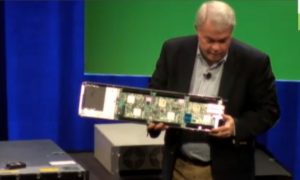
At today's Open Compute Summit in Santa Clara, California, Dell showed off a new generation of X-Gene 64-bit ARM-based servers that the company is developing for data center customers. It also demonstrated new management software based on Open Compute Project standards allowing remote control of both Intel and ARM-based servers. The software and server designs Dell demonstrated would allow Intel and ARM-based systems to run in the same chassis.
The latest development server, called Dell Iron, was shown by Dell Chief Architect and Technologist Jimmy Pike. It was built using field-programmable gate arrays (FPGAs) from Applied Micro. Last June, Dell started shipping a 32-bit ARM-based server (called Copper), which was based on a similar architecture, as "microserver" boards plugged into Dell's PowerEdge C5000 chassis. Copper had 4 system-on-a-chip nodes per board; Iron is designed to support six physical ARM servers per board for potentially up to 72 ARM servers in a single 3-unit chassis. And the ARM sleds, which support the Open Compute Project's remote machine management specification, could be installed side-by-side with servers based on Intel and AMD x86-based processors in the same physical chassis.
The problem with massive numbers of ARM-based servers, however, is that they all have to be managed. "We're going to see volumes (of servers) we've never imagined," Pike said in his presentation at the Open Compute Summit.
That's the problem that the OCP strives to address with the Open Hardware Management draft remote control specification. Based on the Data Center Manageability Interface (itself a subset of the Intelligent Platform Management Interface), the spec is intended to ensure a common level of functionality for OCP-based servers in "hyperscale" environments—massive data centers like those of Facebook, Amazon, and Google. It allows for rapid provisioning, reporting of data from onboard sensors, and remote control of power and networking configurations. Pike and Dell demonstrated the Dell Iron board's compatibility with DCMI and the OCP standard, running the ARM development system alongside a set of Intel servers and controlling them with a Project Sputnik laptop running Ubuntu and Ipmitool 1.8.12, an open-source management tool.
Hewlett-Packard has also been looking at ARM processors for its own high-density server program, Project Moonshot, using Calxeda's 32-bit EnergyCore ARM processors in its Redstone demonstration servers—boasting 288 server nodes in a 4U chassis. HP hasn't shipped Redstone to customers yet and in its most recent Moonshot effort, called "Gemini," HP used Intel Atom processors instead of ARM. But HP still says it is committed to ARM servers; in October, the company announced it expected ARM to account for 15 percent of the server market by the end of 2014.
reader comments
32